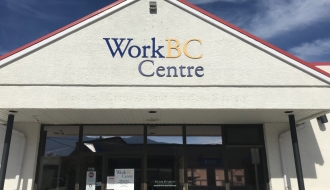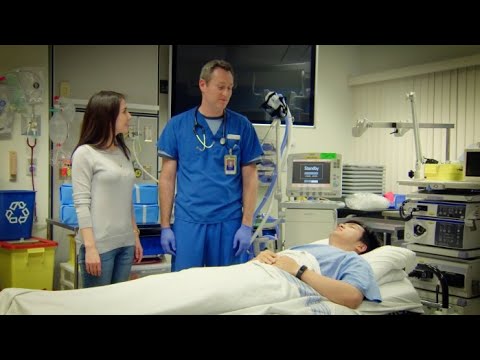Career Overview
Respiratory therapists, clinical perfusionists and cardiopulmonary technologists who are supervisors or instructors are included in this unit group.
Respiratory therapists:
- Assist physicians in the evaluation, diagnosis, treatment and care of patients with respiratory and cardiopulmonary disorders
- Perform cardiopulmonary technology duties, assisting physicians in the technical aspects of diagnosis and treatment of cardiovascular and pulmonary disease
- Work in hospitals, extended care facilities, public health centres, sleep, private or dental clinics and respiratory home-care companies
Clinical perfusionists (also known as cardiovascular perfusionists):
- Provide technical support to patients undergoing cardiac surgery and patients requiring cardio-respiratory support
- Are highly specialized practitioners who manage cardiopulmonary and other life support devices for patients undergoing cardiovascular surgery
- Work mainly in hospitals
Cardiopulmonary technologists:
- Assist physicians in the technical aspects of diagnosis and treatment of cardiovascular and pulmonary disease
- Work mainly in hospitals
The cardio-pulmonary technologist profession is not formally recognized as a discipline in B.C., but is in other jurisdictions in Canada.
People in these occupations:
- Should have strong interpersonal skills in order to work well with staff and patients
- Should have good attention to detail
- Should have good computer and equipment skills
- Must also be able to follow instructions and work well under pressure
Job Titles
Duties
Respiratory therapists and clinical perfusionists share some of the same duties, such as training students and participating in research, as described below.
Special duties
Respiratory therapists:
- Run diagnostic tests, such as arterial blood gas analysis and cardiopulmonary functions tests
- Operate and monitor respiratory equipment to give treatments such as oxygen, oxygen-air mixtures, humidified air or medications
- Operate, monitor, maintain and test a variety of diagnostic and therapeutic equipment
- Assess patients and perform or help with interventions, such as airway maintenance, line insertions, inductions and intubations
- Do artificial respiration and external cardiac massage and help transport high-risk patients
- Supervise and train students and other respiratory therapists
- May participate in home-care programs for chronic respiratory patients and provide patient and family education
- Participate in research related to cardiac and pulmonary disorders.
- Respiratory therapists in B.C. also perform cardiopulmonary duties, as described below under the description for cardiopulmonary technologists
Clinical perfusionists:
- Assemble, maintain and operate extracorporeal circulation equipment, intra-aortic balloon pumps and other heart assist devices to support or temporarily replace patients' cardiopulmonary functions during open-heart surgery
- Administer blood products, drugs and other substances through heart-lung machines and other devices as directed by cardiac surgeons and anaesthetists to maintain adequate flow of oxygenated blood to all organs of the body
- Monitor vital signs to support and maintain patients' physiological functions and metabolic needs during cardiopulmonary surgery
- Participate in routine maintenance, calibration and inspection of all perfusion related equipment
- Supervise and train student clinical perfusionists and other clinical perfusionists.
NOTE: The cardiopulmonary technologist profession is not formally recognized as a discipline in B.C. since respiratory therapists perform these functions:
- Perform diagnostic tests in other Canadian jurisdictions such as pulmonary function and asthma stress tests, or help physicians with cardiac and cardiopulmonary stress tests and bronchoscopies
- Determine patients' blood characteristics such as activated clotting time and oxygen saturation
- Operate, monitor, maintain, calibrate and test diagnostic and therapeutic equipment
- Monitor patients and advise the physician of any changes in a patient's condition
- Prepare medications and give inhaler and other treatments under the supervision of a cardiologist
- Provide information and care for patients during tests
- Help prepare the cardiac catheterization room, prepare specialized catheters and help cardiologists during catheterization
- Do analysis, programming and monitoring of implanted devices such as pacemakers and defibrillators during surgery
- Supervise and train students and other cardiopulmonary technologists
- Provide technical support for research
Earnings
Earnings is income that workers receive in exchange for their labour. Depending on the type of employment, earnings can be in the form of wages (hourly), salaries (fixed monthly or annual) or self-employed earnings.
Work Environment
# Workers Employed
1,405% Employed Full Time
65%Most workers in these occupations work a typical workweek. However, 8- to 12-hour shifts, usually on rotation, including weekends, evenings, nights and holidays can be common. In addition, workers may be on call for emergencies and be required to work long hours.
Respiratory therapists, clinical perfusionists and cardiopulmonary technologists generally work in health-care facilities. The work is physically demanding since these workers spend long periods standing and walking throughout hospitals. The work also involves a lot of bending and lifting.
Workers may also have to cope with the emotional aspects of working with the sick, injured and terminally ill, as well as patients' families.
These workers can be exposed to infectious disease so infection control and sterilization procedures are followed to reduce this risk.
Career Pathways
Respiratory therapists may specialize in areas such as anesthesia, critical care, pediatrics, cardiopulmonary diagnostics and respiratory home and community care, research and private health industry.
Experienced respiratory therapists, clinical perfusionists and cardiopulmonary technologists may advance to clinical specialist, supervisory positions or teaching.
Related Careers
Occupational Interests
It’s important to understand what kinds of occupations align with your interests.
For more about occupational interests visit Skills for the Future Workforce > Characteristics.
Here are the top occupational interest(s) for this career profile:
Education, Training and Skills
Entry-level training programs in respiratory therapy, clinical perfusion and cardiopulmonary technology (outside of B.C.) are generally two to three years in length. To become a Registered Respiratory Therapist (RRT) with the Canadian Society of Respiratory Technologists (CSRT) requires:
- Completion of an accredited Respiratory Therapy program in Canada.
- Completion of the national registration exams provided by the Canadian Board for Respiratory Care.
All respiratory therapy training programs in Canada are a minimum of three years. Respiratory therapists may also become members of the British Columbia Society of Respiratory Therapists (BCSRT). For more information, visit the CSRT website at www.csrt.com and the BCSRT website at www.bcsrt.com.
Clinical perfusionists must be certified or eligible for certification by the Canadian Society of Clinical Perfusion (CSCP). Certification requires:
- Completion of a bachelor's degree.
- Completion of an accredited clinical perfusion program.
- Completion (or challenge) of the CSCP national credentialing exam.
Those currently enrolled in an accredited clinical perfusion program can become student members. For more information, visit www.cscp.ca. In jurisdictions outside of B.C., in order to become a Registered Cardiopulmonary Technologist with the Canadian Association of Cardio-pulmonary Technologists (CACPT) candidates must write the CACPT registration exams. In order to write the exams, they must:
- Have a Bachelor of Science degree or medical technology diploma in an appropriate discipline, or a nursing degree or diploma.
- Be able to demonstrate practical experience through work experience or completion of a recognized cardiovascular program or pulmonary courses.
Visit the CACPT website at www.cacpt.ca for more information.
Workers who are certified for an occupation by a regulator elsewhere in Canada can apply for the same certification from the regulator in B.C. Under the terms of the Canadian Free Trade Agreement (CFTA), most applicants who are transferring their credentials from elsewhere in Canada will not be required to complete additional training or testing. However, the B.C. regulator may ask applicants to provide further information such as a letter of good standing, references, or criminal record check.
For those who trained outside of Canada and never received certification from any Canadian jurisdiction, a full assessment is likely needed. Most occupational regulators have a process for assessment and recognize internationally trained applicants.
For information about labour mobility in Canada, visit www.workersmobility.ca.
View a list of Professional Regulatory Authorities in B.C.
Education programs in B.C.
The following program areas are related to this occupation:
- Diagnostic Technology & Related

Skills
Every job calls for a certain set of skills. Knowing those skills is the first step in finding a good career fit.
Here, you will find the 10 most relevant workplace skills. Some are more important to achieving success in a certain career than others. These skills may come naturally to you or you may need to gain them through education, training and experience.
See the list of work-related skills below, ranked in order of importance for this career. Check out the list and see if this career matches your skills—take that first step!
Giving full attention to what other people are saying, taking time to understand the points being made, asking questions as appropriate, and not interrupting at inappropriate times.
Talking to others to share information effectively.
Using logic and reasoning to identify the strengths and weaknesses of alternative solutions, conclusions or approaches to problems.
Understanding written sentences and paragraphs in work-related documents.
Being aware of others’ reactions and understanding why they react as they do.
Keeping track of and assessing your performance, other individuals, or organizations to make improvements or take corrective action.
Actively looking for ways to help people.
Understanding how new information could be used to solve current and future problems in making decisions.
Considering the relative costs and benefits of potential actions to choose the most appropriate one.
Being able to solve novel, ill-defined problems in complex, real-world settings.
Labour Market Statistics
Discover data, facts and information that have been gathered and analyzed. Learn about the characteristics of the economy and labour market in B.C.
Employment
Find out about employment types and trends by region and industry.
Employment
1,405Employment by Region







| Region | Employment | % Employment of this Occupation |
|---|---|---|
| Cariboo | 35 | 2.5% |
| Kootenay | 35 | 2.5% |
| Mainland/Southwest | 895 | 63.7% |
| North Coast and Nechako | 0 | 0.0% |
| Northeast | 0 | 0.0% |
| Thompson-Okanagan | 205 | 14.6% |
| Vancouver Island/Coast | 230 | 16.4% |
Labour Market Outlook
The B.C. Labour Market Outlook is a 10-year forecast of the expected supply and demand for labour in the province. It’s usually updated every year. The purpose is to provide British Columbians with the knowledge to make informed decisions on careers, skills training, education and hiring.
Forecasted Job Openings (2024-2034)
1,020Forecasted Job Openings
Forecasted Employment Growth Rate
Composition of Job Openings
Job Openings by Region (2024-2034)







| Region | Job Openings | Avg. Annual Employment Growth |
|---|---|---|
| Cariboo | 20 | 1.6% |
| Kootenay | 10 | 1.2% |
| Mainland/Southwest | 680 | 2.5% |
| North Coast and Nechako | Not available | Not available |
| Northeast | Not available | Not available |
| Thompson-Okanagan | 120 | 1.9% |
| Vancouver Island/Coast | 190 | 2.3% |
Industry Highlights
Learn about the opportunities in B.C.'s major industries, including employment trends, earning potential, locations of work and more.
Forecasted Job Openings by Industry
| Industry | Job Openings (2024-2034) |
|---|---|
| Health Care and Social Assistance | 1,000 |
| Retail Trade | 10 |
Insights from Industry
Job opportunities are expected to come from retirements and new job creation.
The growing demand for health-care services will increase work opportunities for these workers. In particular, hospitals and related health-care facilities are expected to experience growth that will result in new jobs.
An older population will see an increase in respiratory ailments and cardiopulmonary diseases, such as pneumonia, chronic bronchitis, emphysema and heart disease, thereby increasing the need for health-care workers in this group. Advances in treatment for heart attacks, accidents and premature babies will also continue to increase demand for workers in these occupations.
Growth in the Health Care and Social Assistance industry will be somewhat offset by efforts to better run the medical system so costs do not get out of control. Cost management measures include reduced hospital stays, increased outpatient services, and prevention and wellness programs.
Advances in medical technologies, treatments and procedures mean that these workers must stay on top of new innovations to be effective in their jobs.
Industry sources report that there is currently a significant shortage of respiratory therapists, particularly in larger hospitals, and that the current supply of graduates cannot fill the vacancies. To meet their staffing needs, B.C. employers continue to look for respiratory therapists from other provinces and internationally.
The current supply of clinical perfusion graduates is also insufficient due to a lack of a clinical perfusionist programs in western Canada. A new perfusionist program is now available at the British Columbia Institute of Technology.
Resources
-
B.C. Ministry of Healthwww.gov.bc.ca/health
-
BC Children's Hospital – Careerswww.bcchildrens.ca/careers
-
British Columbia Society of Respiratory Therapists (BCSRT)www.bcsrt.com
-
Canadian Association of Cardio-pulmonary Technologists (CACPT)www.cacpt.ca
-
Canadian Society of Respiratory Therapists (CRST)www.csrt.com
-
National Alliance of Respiratory Therapy Regulatory Bodies (NARTRB)www.nartrb.ca
-
Provincial Health Services Authority (PHSA) – Jobsjobs.phsa.ca/









